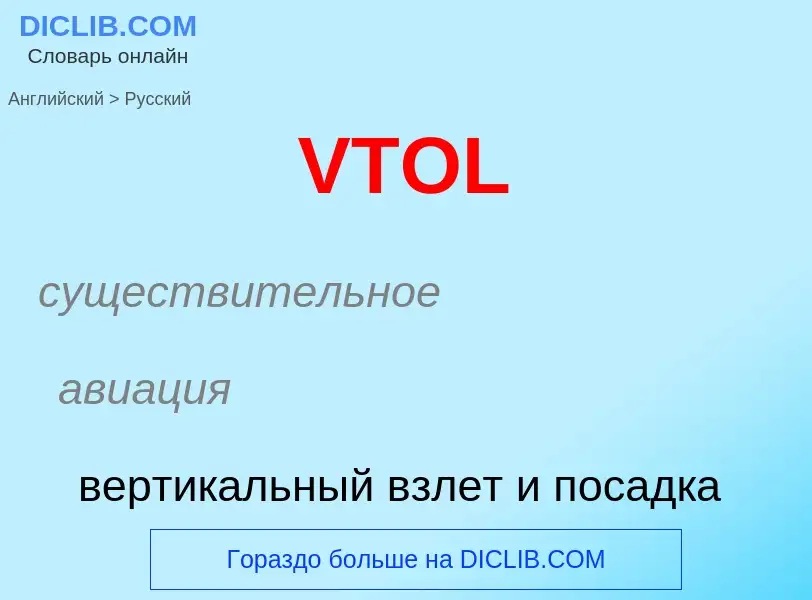Traduzione e analisi delle parole tramite l'intelligenza artificiale ChatGPT
In questa pagina puoi ottenere un'analisi dettagliata di una parola o frase, prodotta utilizzando la migliore tecnologia di intelligenza artificiale fino ad oggi:
- come viene usata la parola
- frequenza di utilizzo
- è usato più spesso nel discorso orale o scritto
- opzioni di traduzione delle parole
- esempi di utilizzo (varie frasi con traduzione)
- etimologia
VTOL - traduzione in russo
существительное
авиация
вертикальный взлет и посадка
синоним
['dʒʌmpdʒet]
общая лексика
джамп-джет (разговорное название истребителя "Харриер" [Harrier])
дословная передача
реактивный самолёт-прыгун
существительное
общая лексика
реактивный самолет с вертикальным взлетом и вертикальной посадкой
Wikipedia
A vertical take-off and landing (VTOL) aircraft is one that can take off and land vertically without relying on a runway. This classification can include a variety of types of aircraft including helicopters as well as thrust-vectoring fixed-wing aircraft and other hybrid aircraft with powered rotors such as cyclogyros/cyclocopters and gyrodynes.
Some VTOL aircraft can operate in other modes as well, such as CTOL (conventional take-off & landing), STOL (short take-off & landing), or STOVL (short take-off & vertical landing). Others, such as some helicopters, can only operate as VTOL, due to the aircraft lacking landing gear that can handle taxiing. VTOL is a subset of V/STOL (vertical or short take-off & landing).
Some lighter-than-air aircraft also qualify as VTOL aircraft, as they can hover, takeoff and land with vertical approach/departure profiles.
Electric vertical takeoff and landing aircraft, or eVTOLs, are being developed along with more autonomous flight control technologies and mobility-as-a-service (MaaS) to enable advanced air mobility (AAM), that could include on-demand air taxi services, regional air mobility, freight delivery, and personal air vehicles (PAVs).
Besides the ubiquitous helicopters, there are currently two types of VTOL aircraft in military service: tiltrotor aircraft, such as the Bell Boeing V-22 Osprey, and thrust-vectoring airplanes, such as the Harrier family and new F-35B Lightning II Joint Strike Fighter (JSF). In the civilian sector currently only helicopters are in general use (some other types of commercial VTOL aircraft have been proposed and are under development as of 2017). Generally speaking, VTOL aircraft capable of STOVL use it wherever possible, since it typically significantly increases takeoff weight, range or payload compared to pure VTOL.

![U.S. Marines jump from a [[Bell-Boeing V-22 Osprey]], the first production [[tiltrotor]] aircraft U.S. Marines jump from a [[Bell-Boeing V-22 Osprey]], the first production [[tiltrotor]] aircraft](https://commons.wikimedia.org/wiki/Special:FilePath/Aircraft.osprey.678pix.jpg?width=200)
![VJ101]] on display at the [[Deutsches Museum]], [[Munich, Germany]] VJ101]] on display at the [[Deutsches Museum]], [[Munich, Germany]]](https://commons.wikimedia.org/wiki/Special:FilePath/Aircraft VJ101C top.jpg?width=200)
![Canadair CL-84 Dynavert CL-84-1 (''CX8402'') on display at the [[Canada Aviation and Space Museum]] in Ottawa, Ontario Canadair CL-84 Dynavert CL-84-1 (''CX8402'') on display at the [[Canada Aviation and Space Museum]] in Ottawa, Ontario](https://commons.wikimedia.org/wiki/Special:FilePath/CanadairCL-84DynavertSerialCX8402.jpg?width=200)

![Do 31 E3]] on display at the [[Deutsches Museum]], Germany Do 31 E3]] on display at the [[Deutsches Museum]], Germany](https://commons.wikimedia.org/wiki/Special:FilePath/Do-31 2.jpg?width=200)



![A [[Schiebel Camcopter S-100]], a modern VTOL [[unmanned aerial vehicle]] A [[Schiebel Camcopter S-100]], a modern VTOL [[unmanned aerial vehicle]]](https://commons.wikimedia.org/wiki/Special:FilePath/Schiebel CAMCOPTER S-100.jpg?width=200)


